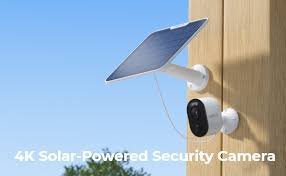
solar security camera
Why Choose a Solar Security Camera Today
In a world where safety, sustainability, and smart living go hand in hand, the solar security camera has become a standout innovation. Designed to provide wireless surveillance using renewable energy, these cameras are not just eco-friendly—they’re practical, affordable, and highly efficient. Whether you’re protecting a home, a farm, a construction site, or even an RV, solar-powered cameras offer continuous monitoring without the need for electrical wiring. Thanks to motion detection, night vision, cloud storage, and remote access via apps, a solar security camera gives you 24/7 peace of mind—powered by the sun.
How Solar Security Cameras Work
A solar security camera uses a solar panel to convert sunlight into energy, which charges an internal battery that powers the camera. These cameras are typically wireless, meaning there’s no need for external power or data cables. Most models connect to your Wi-Fi network or use cellular data (4G/5G) for real-time video transmission. As the sun charges the battery during the day, the camera can operate day and night—even in low sunlight or cloudy conditions.
The basic components of a solar camera system include:
- A solar panel (built-in or external)
- A lithium battery for energy storage
- A camera unit with HD or 2K/4K resolution
- Infrared LEDs for night vision
- Motion sensors (PIR) for activity detection
- Wi-Fi or SIM connectivity for remote access
With no wiring, no electric bills, and minimal maintenance, solar-powered surveillance is ideal for modern homes and remote locations alike.
Top Benefits of Using Solar Security Cameras
1. 100% Wireless Installation: With no power cords or complicated setups, you can mount these cameras anywhere—on trees, fences, walls, poles, or sheds.
2. Eco-Friendly Operation: These systems rely on clean, renewable solar energy, reducing your environmental footprint and energy costs.
3. Remote Monitoring: Most cameras are accessible through mobile apps, allowing you to view live footage, receive alerts, and playback video from anywhere in the world.
4. Motion-Activated Recording: Built-in PIR sensors trigger the camera to start recording only when motion is detected, saving battery and storage.
5. Weatherproof Design: Most solar security cameras are IP65 or IP66 rated, meaning they can withstand rain, heat, dust, and snow.
6. Cost-Effective: After the initial investment, these cameras have no recurring power costs, making them more affordable than wired systems in the long run.
7. Easy Scalability: Add multiple cameras around your property without worrying about extra wiring or circuits.
From smart homes to off-grid cabins, solar cameras are a versatile, future-ready solution.
Best Use Cases for Solar Security Cameras
You can install solar security cameras practically anywhere the sun shines. Some common applications include:
- Home Security: Front doors, backyards, garages, driveways, or gates
- Farms & Barns: Monitor livestock areas, feed stores, or fencing lines
- Construction Sites: Temporary, wireless surveillance for materials and equipment
- Vacation Properties: Watch over cabins or rental homes remotely
- RVs & Mobile Homes: Keep your vehicle and campsite secure during travels
- Warehouses & Storage Yards: Add coverage to remote corners where wiring is impractical
- Businesses: Monitor outdoor inventory, parking lots, and loading docks
With 360-degree coverage options, solar-powered PTZ cameras, and smart motion alerts, these devices can match almost any use case.
Key Features to Look for in a Solar Security Camera
When choosing the best solar security camera, focus on the following features to match your needs:
- Battery Capacity: Larger battery (6000mAh or more) ensures longer operation even during cloudy days
- Solar Panel Wattage: A high-efficiency monocrystalline panel captures more sunlight in less time
- Resolution: Look for 1080p minimum, though 2K or 4K models are now common for sharper detail
- Night Vision: Ensure the camera has infrared or color night vision with strong range (up to 30ft or more)
- Motion Detection: PIR (Passive Infrared) sensors for accurate motion alerts without false triggers
- Two-Way Audio: Lets you speak and listen via the camera—ideal for visitors, delivery personnel, or intruders
- Storage Options: Choose between cloud storage, local SD card, or both
- Smartphone App Support: Check if it works with Android & iOS apps, and whether it sends push notifications
- Weatherproofing: IP65 or above ensures durability in outdoor environments
- Connectivity: Decide between Wi-Fi, LTE (SIM card), or hybrid models for remote locations
By focusing on these specs, you can find a solar security camera that’s tailored to your location and lifestyle.
Top 5 Solar Security Cameras You Can Buy Today
Here are some of the most reliable, best-reviewed solar security cameras on the market:
1. Reolink Argus 3 Pro
A powerful camera with 2K resolution, PIR motion detection, smart alerts, and a rechargeable battery. Includes a solar panel and works over Wi-Fi.
🔗 View Reolink Argus 3 Pro
2. Ring Stick Up Cam Solar
Part of the Amazon ecosystem, this camera offers motion-activated alerts, live view, and two-way talk, with optional Ring Protect cloud subscription.
🔗 Check Ring Solar Cam
3. Arlo Essential XL Spotlight Camera
Includes a built-in spotlight, long battery life, and supports color night vision. Arlo’s cloud features offer smart AI-based motion detection.
🔗 **Explore Arlo XL Solar **
4. Soliom S600 Outdoor PTZ Camera
This pan-tilt-zoom solar camera offers 355° horizontal and 90° vertical rotation, ideal for farms or large yards. Includes 4G LTE version for remote use.
🔗 View Soliom S600
5. Zumimall Solar Outdoor Camera
A budget-friendly, wireless solar camera with night vision, motion alerts, and easy setup. Good choice for basic home monitoring.
🔗 Buy Zumimall Camera
These models combine performance, durability, and smart tech for a range of budgets and applications.
How to Install a Solar Security Camera
Installing your solar-powered security camera is simple and requires no electrician:
- Choose a sunny location that gets at least 4–6 hours of sunlight daily
- Mount the camera with included screws or adhesive bracket
- Adjust the solar panel angle to face direct sunlight (usually south-facing is best)
- Connect to Wi-Fi or insert SIM card, depending on model
- Download the app, scan the QR code, and finish setup
- Test motion detection and view footage on your mobile app
Most installations take 15–30 minutes, and since these cameras are fully wireless, you can reposition them easily.
Common Questions About Solar Security Cameras
Q: What happens at night or on cloudy days?
The camera runs on its internal battery, which is charged during the day. A full battery can power the camera for 3–7 days, depending on usage.
Q: Can solar security cameras record 24/7?
Most record only when motion is detected, but some premium models support continuous recording with large SD cards or cloud plans.
Q: Do solar cameras work indoors?
Yes, if the solar panel is mounted outdoors, and the camera unit is placed inside.
Q: Is cloud storage free?
Some brands offer free basic plans, while others charge monthly. Always check before purchasing.
Q: Can I install these in rural areas without Wi-Fi?
Yes—4G LTE-enabled solar security cameras are perfect for off-grid locations.
Conclusion: Power Your Security with the Sun
The solar security camera is a perfect fusion of modern technology and environmental consciousness. It offers everything from wireless flexibility to eco-friendly operation, combined with advanced surveillance features like HD video, night vision, two-way audio, and mobile alerts. Whether you’re guarding your home, a remote farm, or a construction site, these cameras bring powerful protection without wiring, contracts, or electricity bills. With just a few hours of sunshine each day, you can stay protected 24/7—and do it sustainably. So if you’re ready to go wireless, go green, and go smart, it’s time to invest in a solar security camera that works as hard as you do.






